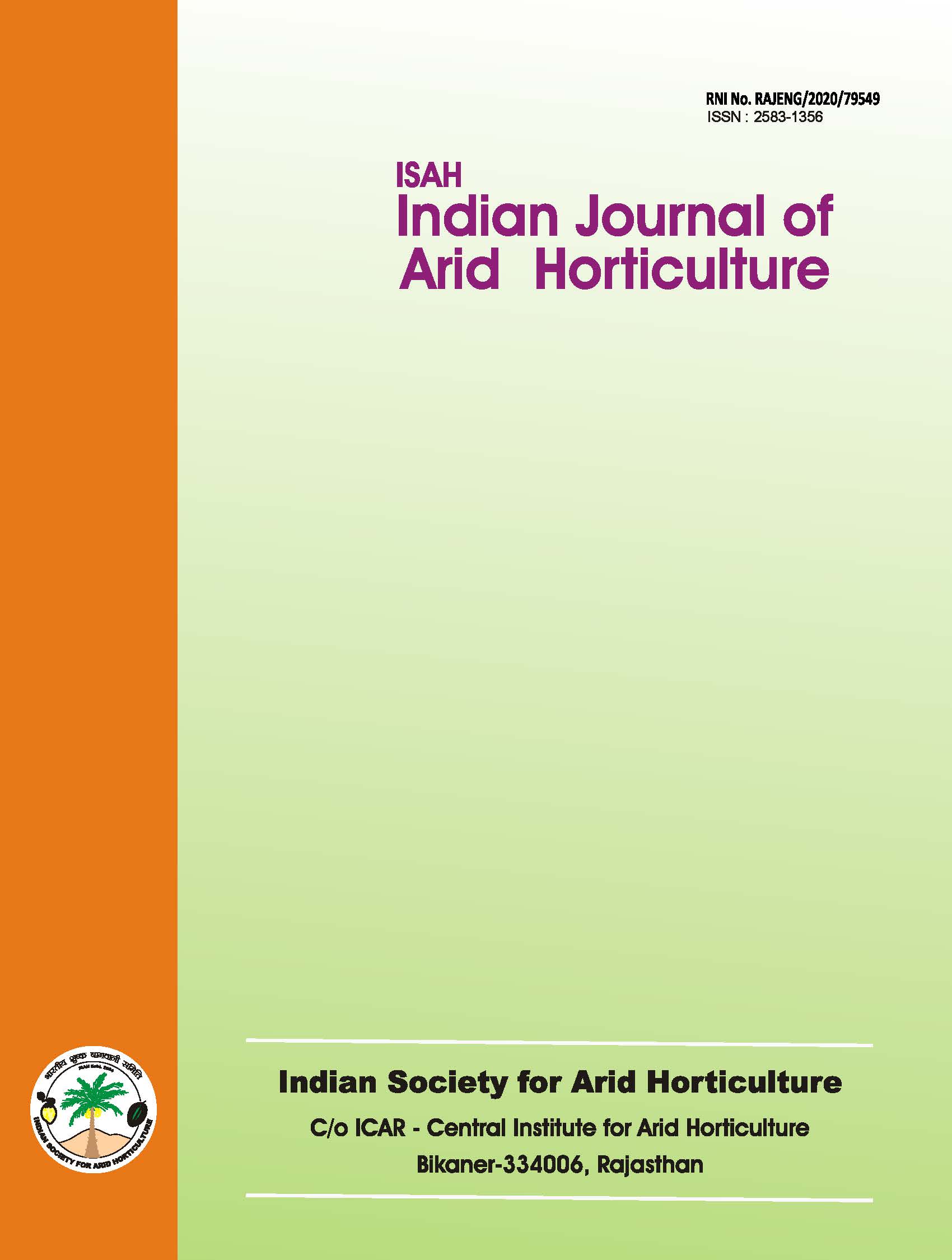Arid Horticulture: An Overview
Keywords:
Arid region, horticulture, orchard managementAbstract
The arid region is spread over 38.7 million hectares, mainly in the states of Rajasthan, Gujarat, Haryana, Punjab, and Andhra Pradesh. The area is marked by extreme climatic conditions, making the cultivation of traditional crops non-economical. In such a situation, arid horticulture offers ample scope to develop these regions. The present communication attempts to provide an overview of the technologies developed that can be used to transform the arid ecosystem into a horticultural hub, ensuring income generation and nutritional security for the inhabitants.Downloads
References
Anonymous, 1985. Proceedings. Third National Workshop on Arid Zone Fruits Research. Mahatma Phule Agricultural University, Rahuri, July 1985. Tech. No. 1, Hisar, India: Coordination Cell, AICRP on Arid Zone Fruits, ICAR.
Anonymous, 1989. Proceedings. Fifth National Workshop on Arid Zone Fruit Research, Gujarat Agricultural University, Sardarkrushinagar, July 6-8, 1989. Tech. Doc. No. 27, Hisar, India: Coordination Cell, AICRP on Arid Zone Fruits, ICAR.
Anonymous, 1991. Proceedings. Group Meeting of Research Workers on Arid Zone Fruits. Indian Institute of Horticultural Research, Bangalore, December 18-20, 1991. Tech. Doc. No. 31. Coordination Cell, AICRP on Arid Zone Fruits, ICAR.
Anonymous, 1997. Annual Progress Report, NRC for Arid Horticulture, Bikaner.
Anonymous, 1998. Annual Progress Report, NRC for Arid Horticulture, Bikaner.
Anonymous, 2002. Annual Progress Report, Central Institute for Arid Horticulture, Bikaner.
Anonymous, 2004. Proceedings. Group Meeting of Research Workers on Arid Zone Fruits, ARS, Kumarganj, Faizabad, April 2004. Coordination Cell, AICRP on Arid Zone Fruits, ICAR.
Anonymous, 2006. Biennial Report (2004-05) of XIII Group Workers Meeting of AICRP on Arid Zone Fruits held during May 10-12, 2006 at S.D. Agricultural University, S.K. Nagar, Dantiwada, Gujarat.
Awasthi, O.P., 2006. Annual Report 2005-06, AP Cess Fund Scheme on Aonla-based Multistrata Cropping System submitted to ICAR, New Delhi.
Awasthi, O.P., Singh, I.S., and Sharma, B.D., 2006. Effect of mulch on soil hydrothermal regimes, growth, and fruit yield of brinjal under arid conditions. Indian Journal of Horticulture, 63(2): 192-194.
Arora, Y.K., and Mohan, S.C., 1998. Water harvesting and moisture conservation for fruit crops in Doon valley. National Seminar on Dryland Horticulture, July 20-22, 1988, CRIDA, Hyderabad.
Chundawat, B.S., 1990. Arid Fruit Culture. New Delhi, India: Oxford & IBH Publication Co. Pvt. Ltd.
Dhandar, D.G., Saroj, P.L., Awasthi, O.P., and Sharma, B.D., 2004. Crop diversification for sustainable production in irrigated hot arid eco-system of Rajasthan. Journal of Arid Land Studies, 148: 37-40.
Eswaran, H., 1992. Role of soil formation in meeting the challenges of sustainable land management. Journal of Indian Society of Soil Science, 40: 6-24.
Gupta, J.P., 1995. Water losses and their control in rainfed agriculture. In: Singh, R.P. (ed.), Sustainable Development of Dryland Agriculture in India. Jodhpur, India: Scientific Publishers, pp. 169-176.
Jones, R.J., and Mansfield, T.A., 1971. Antitranspirant activity of the methyl and phenyl esters of abscisic acid. Nature, 231: 331-332.
Muthana, K.D., Yadav, U.S., Mertia, R.S., and Arora, G.D., 1984. Shelterbelt plantations in arid regions. Indian Farming, 3: 19-21.
Pareek, O.P., 1978. Quicker way for raising ber orchards. Indian Horticulture, 23: 5-6.
Pareek, O.P., 1993. Irrigation management in fruit crops. In: Singh, D.P. and Sharma, H.C. (Eds.), Important Aspects of On-farm Water Management. CCHA, Hisar.
Pareek, O.P., 1999. Dryland Horticulture. In: Singh et al. (Eds.), Fifty Years of Dryland Agricultural Research in India. CRIDA, Hyderabad.
Pareek, O.P., and Sharma, S., 1991. Fruit trees for arid and semi-arid lands. Indian Farming, 41: 25-30.
Pareek, O.P., and Vishal Nath, 1996. Coordinated Fruit Research in Indian Arid Zone - A Two Decade Profile. NRC for Arid Horticulture, Bikaner.
Raturi, G.B., and Hiwale, S.S., 1988. Horticulture-based cropping systems for drylands. In: National Seminar on Dryland Horticulture, July 20-22, 1988, CRIDA, Hyderabad.
Saroj, P.L., Dubey, K.C., and Tiwari, R.K., 1994. Utilization of degraded lands for fruit production. Indian Journal of Soil Conservation, 22(1&2): 162-176.
Saroj, P.L., Samra, J.S., Sharma, N.K., Dadbwal, K.S., Shrimali, S.S., and Arora, Y.K., 1999. Mango-based agroforestry systems in degraded foothills of north-western Himalayan region. Indian Journal of Agroforestry, 1(2): 121-128.
Sharma, B.D., Dhandar, D.G., and Vashishtha, B.B., 2002. Response of ber (Ziziphus mauritiana var. rotundifolia Lamk.) to drip fertigation in aridisols of western Rajasthan. Abstract, National Seminar on Sustainable Management of Water Resources for Enhanced Agricultural Production, held during April 26-28, 2002, at Dr. Balasaheb Sawant Konkan Krishi Vidyapeeth, Dapoli.
Sharma, K.D., Pareek, O.P., and Singh, H.P., 1982. Effect of runoff concentration on growth and yield of jujube. Agriculture and Water Management, 5: 73-84.
Sharma, K.D., Pareek, O.P., and Singh, H.P., 1986. Microcatchment water harvesting for raising jujube orchards in arid climate. Transactions of the ASAE, 29: 112-118.
Shukla, A.K., Singh, D., Meena, S.R., Singh, I.S., Bhargava, R., and Dhandar, D.G., 2006. Enhancement of water use efficiency in aonla through double ring system of irrigation under hot arid agro-ecosystem. Abstract, National Seminar on Input Use Efficiency, held at IIHR, Bangalore, August 9-11, 2006, pp. 99.
Singh, R.P., and Vishnumurthy, T., 1988. Micro-reliefs for citrus and vegetables under dryland conditions. National Seminar on Dryland Horticulture, July 20-22, 1988, CRIDA, Hyderabad.
Srinivas, K., Vittal, K.P.R., and Sharma, K.L., 1999. Resource characterization of dryland soils. In: Singh et al. (Eds.), Fifty Years of Dryland Agricultural Research in India. CRIDA, Hyderabad, India.

